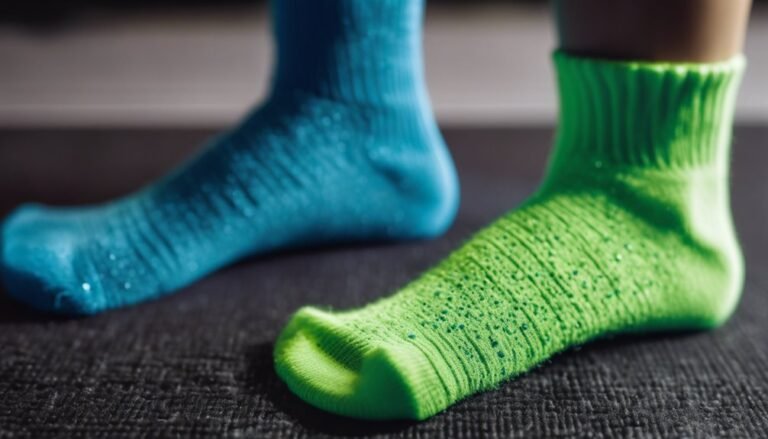The Role of Socks in Military History: From Roman Soldiers to Modern Combat Boots
Have you ever noticed how something as simple as a pair of socks can make or break your day? Now, imagine being a soldier, marching for miles in harsh conditions. It's not just a matter of comfort; it's a matter of survival.
From Roman soldiers who wore woolen "udones" to our modern combat-ready troops, socks have played a crucial role in military history. They've evolved from using materials like leather and wool to incorporating advanced smart textiles, adapting to various terrains and climates.
Their importance is not just about reducing blisters but also about boosting morale and preventing severe conditions like trench foot. These innovations have consistently enhanced military performance, offering a glimpse into the fascinating evolution of an often-overlooked piece of military gear.
The Origins of Military Footwear: Ancient Times

While the significance of military footwear might seem understated, its origins trace back to ancient times when foot protection was essential for soldiers marching into battle. You'll find that ancient footwear had to be both durable and adaptable to the diverse terrains encountered by armies. Early designs prioritized functionality over form, often made from leather or simple woven materials. This period marked the beginning of sock evolution, where rudimentary foot coverings were crafted to offer additional warmth and reduce friction. Ancient warriors understood that proper footgear was vital for maintaining mobility and morale. This foresight not only safeguarded their feet but also laid the groundwork for future innovations in military attire. Understanding this evolution underscores the timeless value of adaptability and resilience in achieving one's freedom.
Socks in the Roman Legions: Marching Across Empires
When considering the Roman legions, you might not immediately think of the socks they wore, yet these garments were essential. Made from materials like wool and leather, socks played a significant role in enhancing soldier mobility across diverse terrains. By adapting their design to suit different climates, Roman soldiers could march more effectively, maintaining the empire's expansive reach.
Early Sock Materials
Socks, though often overlooked, played an indispensable role in the success of Roman legions as they marched across vast and varied terrains. Early Roman socks, or "udones," were crafted using natural fibers like wool and linen. These materials were chosen for their durability and insulating properties, crucial for enduring both scorching heat and freezing cold. Traditional craftsmanship was crucial in creating these garments. Skilled artisans spun, dyed, and wove fibers by hand, ensuring that each pair met the demands of rigorous military campaigns. By relying on locally sourced materials, Roman soldiers benefited from socks that were both practical and adaptable. This strategic use of materials not only protected their feet but also symbolized the resourcefulness and ingenuity of the Roman military machine.
Influence on Soldier Mobility
As Roman legions traversed the expanse of their burgeoning empire, the humble sock played a pivotal role in enhancing soldier mobility. Imagine the endless marches across rugged terrains; without proper foot protection, fatigue and injury would cripple the most determined legion. Socks, crafted from materials like wool, were essential in safeguarding foot health. They cushioned each step, reducing blisters and sores that could hinder a soldier's effectiveness.
Adaptations for Different Climates
Although often overlooked, the design of Roman socks demonstrated remarkable adaptability to diverse climates encountered during military campaigns. When you examine their construction, you see the clever use of materials that provided climate adaptability. Made from wool or leather, these socks offered essential thermal insulation, vital for soldiers marching through the harsh winters of Northern Europe. In contrast, breathable linen variants were favored in the sweltering deserts of North Africa, allowing for comfort and moisture control.
The Roman military's understanding of environmental demands was sophisticated, ensuring soldiers maintained peak performance despite climatic challenges. By adapting sock materials to suit different terrains, the legions could focus on strategic objectives without being hindered by inadequate footwear. This adaptability not only secured their survival but also their enduring legacy.
The Evolution of Military Socks in the Middle Ages
In the Middle Ages, you'd notice that woolen socks became essential for soldiers, thanks to their warmth and durability in harsh climates. Knights, always seeking an edge in battle, pushed the boundaries of sock design by enhancing fit and protection, accommodating the needs of those encased in heavy armor. These innovations weren't just about comfort; they directly impacted a knight's mobility and endurance on the battlefield.
Woolen Socks Dominance
Throughout the Middle Ages, woolen socks emerged as a staple in military attire, reflecting their significant role in the evolution of soldiers' gear. You might wonder why wool was favored. It's simple: wool benefits were unmatched. Wool provided essential thermal regulation, an important feature for soldiers facing harsh climates. Unlike other materials, wool socks kept feet warm in the cold and cool in heat, ensuring comfort during long marches.
Consider these advantages:
- Moisture-Wicking: Wool's natural fibers helped keep feet dry, reducing blisters.
- Durability: Tough and resilient, wool resisted wear and tear, lasting through grueling campaigns.
- Comfort: Softness and elasticity meant wool socks fit snugly, adapting to each soldier's foot.
Embrace the practicality of wool, a symbol of freedom and endurance.
Knights' Sock Innovations
As woolen socks became synonymous with military attire, the Middle Ages also ushered in a period of innovative adaptations for knights. You'd find that within the confines of knight armor, foot protection was paramount. Knights, encased in heavy metal, relied on socks crafted from robust materials like wool and linen to prevent chafing and blisters. These socks weren't just about comfort; they were essential for agility on the battlefield. Innovations included reinforced soles to withstand the rigors of long marches and the heavy weight of armor. The design evolution didn't stop at practicality; it embraced a form of freedom. Knights sought enhancements that allowed for greater movement, ensuring each step was as unencumbered as their spirit.
Industrial Revolution: Transforming Military Gear

While the Industrial Revolution brought sweeping changes to many sectors, its impact on military gear was particularly transformative. You see, this era marked a shift towards factory production, enabling mass production of military socks and gear. Soldiers no longer had to rely on individually crafted items. Instead, factory-produced socks provided consistent quality and durability. Furthermore, the introduction of ergonomic designs catered to soldiers' comfort, a vital aspect for those spending long hours on their feet.
Consider the following advantages:
- Efficiency: Factory production allowed for rapid scaling and distribution.
- Comfort: Ergonomic designs reduced fatigue and improved soldiers' efficiency.
- Uniformity: Standardized gear guaranteed reliability across different units.
This transformation wasn't just about efficiency; it was about empowering soldiers with better, more reliable equipment.
World Wars and the Standardization of Military Socks
When examining the impact of the World Wars on military attire, it's clear that the standardization of military socks played an essential role in enhancing soldiers' effectiveness. During this era, the need for reliable gear was paramount. Sock standardization emerged as a response to the harsh conditions soldiers faced in trenches and battlefields. Uniformity in sock design guaranteed that every soldier received gear that could withstand moisture and prevent trench foot—a debilitating condition.
Military production ramped up considerably, driven by the demand for millions of pairs of consistent, durable socks. Factories optimized their processes, guaranteeing efficiency in manufacturing. This standardization not only safeguarded soldiers' feet but also reflected a broader trend—a shift towards meeting unique military needs at scale, granting soldiers the freedom to focus on their missions.
Modern Innovations: High-Tech Socks for Today's Soldiers

Even though the battlefield has evolved, the significance of reliable footwear remains constant, and modern innovations in military socks have taken soldier comfort and performance to new heights. Today's high-tech socks incorporate smart textiles and advanced moisture management systems that are essential for operational efficiency and soldier well-being. These innovations guarantee that you're ready for any terrain or climate without sacrificing mobility or comfort.
- Smart Textiles: Embedded sensors monitor foot pressure and temperature, giving you critical real-time data.
- Moisture Management: Advanced fibers wick away sweat, keeping your feet dry and reducing the risk of blisters.
- Durability and Comfort: Reinforced stitching and cushioning provide long-lasting wear and support.
These cutting-edge features empower you to perform at your best, no matter the mission.
Frequently Asked Questions
How Do Socks Impact Soldier Morale and Comfort in Extreme Weather Conditions?
You'll find that sock technology directly impacts morale by ensuring comfort and effective temperature regulation. In extreme weather, maintaining foot health is essential for performance, allowing soldiers the freedom to focus on their mission without distraction.
Are There Specific Sock Regulations Across Different Military Branches?
You're curious about sock standards in the military, aren't you? Each branch has its own specifications, ensuring durability and comfort. These regulations can vary, reflecting unique operational needs while prioritizing soldiers' freedom of movement and overall well-being.
How Do Military Socks Prevent Injuries During Prolonged Marches?
Think of military socks as your foot's best ally, warding off blisters and ensuring foot hygiene during grueling marches. They're designed with moisture-wicking materials and cushioned support, letting you march on without fear of injury.
What Materials Are Commonly Used in Modern Military Socks?
In modern military socks, you'll find wool blends and moisture-wicking materials key for comfort and injury prevention. Wool blends regulate temperature, while moisture-wicking fibers keep feet dry, ensuring freedom from blisters and enhancing mobility during long missions.
How Do Military Socks Differ From Civilian Athletic Socks?
Military socks use advanced sock technology for durability and enhanced moisture-wicking properties, setting them apart from civilian athletic socks. You'll find they're designed to withstand harsher conditions, ensuring comfort and preventing blisters during prolonged wear.







